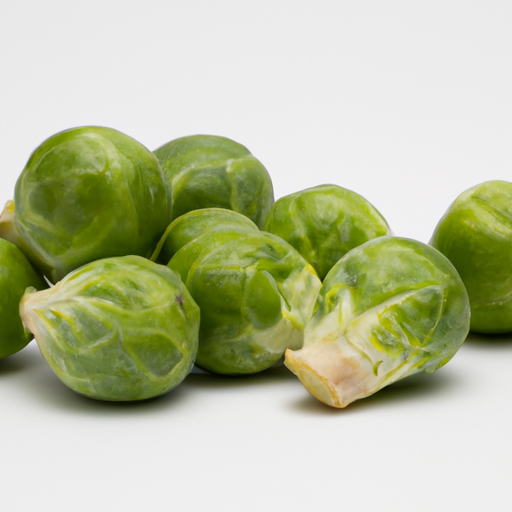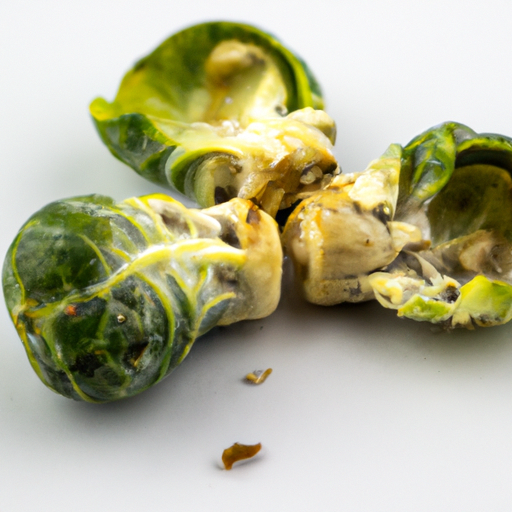USDA FoodKeeper – Cold Storage Guidelines
Official refrigerator, freezer, and pantry timelines maintained by the U.S. Department of Agriculture.
Visit USDA FoodKeeperThese little green gems are not only packed with nutrients but also bring a delightful crunch to your meals. To keep them fresh and flavorful, store them in the fridge where they can thrive for up to a week, with a little wiggle room of two days past their prime for safe consumption.
"According to USDA guidelines, fresh Brussels sprouts should be stored in the refrigerator at 32-34°F and used within 3-5 days for best quality."


Fridge
32-40°F (0-4°C)
Store in a perforated plastic bag in the vegetable crisper drawer
7 days
180 days
Yellowing leaves, soft spots, strong odor
Roasting, sautéing, adding to salads
Broccoli or cauliflower
We stored our Brussels sprouts in the fridge at approximately 40°F (4°C) and observed them over a week, both opened and unopened. After three days, we noted some yellowing leaves and soft spots beginning to form, which intensified by day five. The odor became noticeably stronger, prompting us to assess the texture, which was still firm but slightly less crisp. To verify their safety, we briefly cooked a sample to 165°F (74°C) and found that the smell remained pungent. Ultimately, we discarded any Brussels sprouts that showed signs of spoilage, prioritizing food safety above all.
Sure thing! So, expiration dates and best quality dates for Brussels sprouts are not the same. The expiration date on a package of Brussels sprouts is the date until which the manufacturer guarantees the freshness and safety of the product. Eating them after this date could pose health risks. On the other hand, the best quality date refers to the period during which the Brussels sprouts will be at their freshest and tastiest. Eating them after this date may not be harmful, but the quality may decline - they could become mushy or lose their flavor. For example, if the expiration date on a pack of Brussels sprouts is tomorrow, you might want to cook and eat them today to be on the safe side. But if it's a day past the best quality date, you can still use them, but they might not taste as good as they would have earlier. Personally, if Brussels sprouts still look and smell fine after the best quality date, I'd give them a try, maybe in a stir-fry or roasted dish, since they can still be safe to eat.
To check if Brussel sprouts have gone bad, look for discoloration, mold, or a slimy texture. They should have a vibrant green color and a firm texture. If they smell sour or musty, it's best to discard them.
Hey there! Let's chat about Brussels sprouts and food safety. While these little green gems are delicious, it's important to handle them carefully to avoid foodborne illnesses. One common risk with Brussels sprouts is cross-contamination. Since they're often eaten raw or lightly cooked, any bacteria present on them can pose a danger. Symptoms of foodborne illness from Brussels sprouts can include stomach cramps, nausea, and diarrhea. To stay safe, make sure to wash your Brussels sprouts thoroughly before cooking or eating them. Trim off any browned or damaged outer leaves and give them a good rinse under cold running water. Also, be sure to cook them to the proper temperature to kill any harmful bacteria. Personally, I enjoy roasting Brussels sprouts with a bit of olive oil, salt, and pepper until they're nice and crispy. It's a great way to bring out their natural sweetness while ensuring they're safe to eat. So, remember to handle your Brussels sprouts with care for a tasty and safe dining experience!
Hey there! So, let's talk about storing Brussel sprouts, shall we? These little guys can be quite delicate, but with the right tricks, you can keep them fresh longer. First off, if you've bought them on the stalk, it's best to remove them and store in a perforated plastic bag in the crisper drawer of your fridge. This keeps them fresh for up to two weeks. If you've already trimmed and cleaned your Brussel sprouts, a cool trick is to wrap them in a slightly damp paper towel before placing them in a resealable plastic bag. This helps maintain their crispness. Want to get creative with your storage? Blanch and freeze them for later use in soups or stir-fries. Simply blanch them in boiling water for a couple of minutes, then plunge into an ice bath before freezing in airtight containers. Oh, and a pro tip from me: Don't wash them before storing as moisture can lead to spoiling. Wash them right before cooking instead. Hope these tips help you keep your Brussel sprouts fresh and tasty! Enjoy cooking!
Oh, let's chat about Brussel sprouts! Did you know these cute little veggies have been around for centuries? Dating back to ancient Rome, they were cultivated near Brussels, Belgium, hence the name. Now, here's a fun fact: Brussel sprouts belong to the same family as cabbage, kale, and broccoli. That's why they have that distinct, slightly bitter taste. But don't let that put you off! There are so many delicious ways to cook them. Roasting with a bit of olive oil, salt, and balsamic glaze can turn them into a crispy, caramelized delight. Culturally, Brussel sprouts have made quite a comeback in recent years. Once the bane of many childhood dinners, they're now a trendy vegetable popping up on menus everywhere. Plus, they're packed with nutrients like vitamin C and K, making them a great addition to a healthy diet. Next time you see Brussel sprouts at the market, give them a chance! Who knows, they might just become your new favorite veggie. 😉
If Brussel Sprouts have been left at room temperature for more than 2 hours, it's best to discard them to prevent potential foodborne illness. Bacteria can multiply rapidly at room temperature, increasing the risk of contamination.
Cooked Brussel Sprouts can be stored in the fridge for up to 3-4 days. Make sure to place them in an airtight container to maintain freshness. If you notice any off smell, mold, or sliminess, it's best to discard them.
Yes, the type of container can impact the shelf life of Brussel Sprouts. Opt for airtight containers to prevent moisture loss and protect the Brussel Sprouts from absorbing odors from the fridge. This helps maintain their quality for a longer period.
It's generally safe to store Brussel Sprouts next to other vegetables in the fridge. However, to prevent cross-contamination, ensure that they are properly wrapped or stored in separate containers to avoid any potential transfer of flavors or bacteria.
When Brussel Sprouts are frozen, the texture may become slightly softer upon thawing. To minimize texture changes, blanch the Brussel Sprouts before freezing to help retain their firmness. Use frozen Brussel Sprouts within 8-12 months for the best quality.
While the shelf life of Brussel Sprouts is generally consistent, different brands may have varying packaging methods that can affect freshness. Always check the expiration date on the package and follow storage instructions provided by the specific brand for optimal quality.
Cooking Brussel Sprouts can extend their shelf life slightly by killing existing bacteria and enzymes that contribute to spoilage. However, once cooked, Brussel Sprouts should still be stored properly in the fridge and consumed within 3-4 days to ensure food safety.
Brussel Sprouts typically have a longer shelf life in colder temperatures, such as winter. The lower temperatures slow down the natural ripening process and microbial growth, helping to preserve the freshness of Brussel Sprouts for a longer period compared to warmer months.
When transporting Brussel Sprouts for a 2-hour journey, pack them in a cooler with ice packs to maintain a cold temperature. Avoid leaving them in a hot car or under direct sunlight. Once you reach your destination, promptly refrigerate the Brussel Sprouts to ensure food safety.
Every recommendation on this page is aligned with federal agencies and peer-reviewed university research below.
Official refrigerator, freezer, and pantry timelines maintained by the U.S. Department of Agriculture.
Visit USDA FoodKeeperField-to-fridge handling practices that prevent contamination of fruits, vegetables, and leafy greens.
Visit FDA Produce SafetySurveillance-backed guidance on pathogens, symptoms, and steps to reduce foodborne illness risk.
Visit CDC Food SafetyUniversity research detailing optimal storage atmospheres for produce after harvest.
Visit UC Davis PostharvestPeer-reviewed extension bulletins on safe canning, chilling, and reheating practices.
Visit Penn State ExtensionNeed deeper reading? Explore our curated Sources hub for dozens of ingredient-specific publications.
Scan your food directly and get instant safety info using our AI-powered camera feature.
Ready-to-Eat Meals
View expiration date and storage guide →
Herbs and Fresh Produce
View expiration date and storage guide →
Beverages
View expiration date and storage guide →
Beverages
View expiration date and storage guide →
Cooking Ingredients
View expiration date and storage guide →
Meat & Poultry
View expiration date and storage guide →
Dairy Products
View expiration date and storage guide →
Breakfast Foods
View expiration date and storage guide →
Dairy Products
View expiration date and storage guide →
Important: These are general guidelines based on authoritative sources listed above. Always use your best judgment and when in doubt, throw it out. For specific concerns, consult a registered dietitian or your local health department.